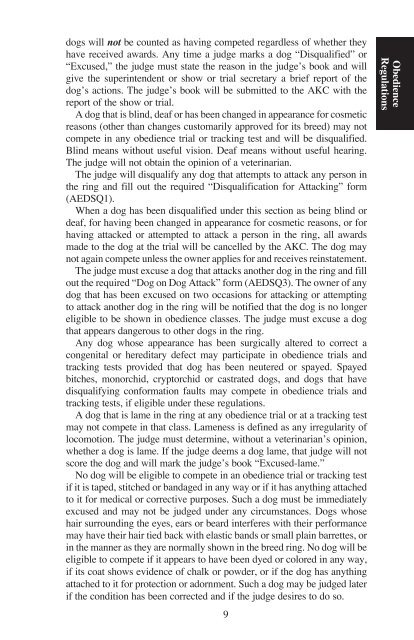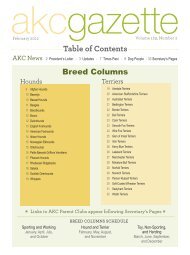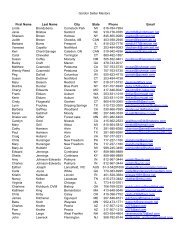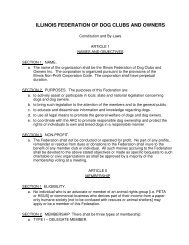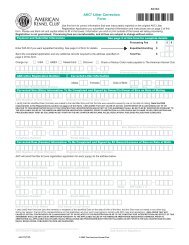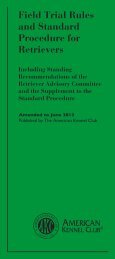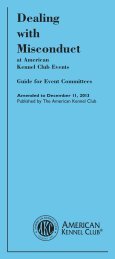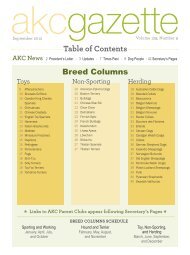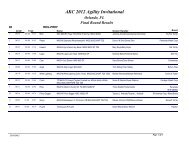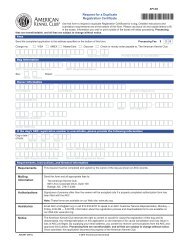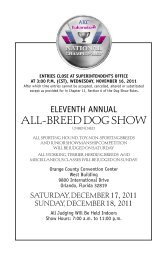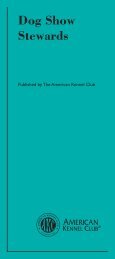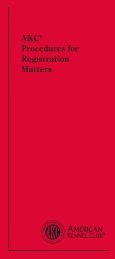Obedience Regulations - American Kennel Club
Obedience Regulations - American Kennel Club
Obedience Regulations - American Kennel Club
You also want an ePaper? Increase the reach of your titles
YUMPU automatically turns print PDFs into web optimized ePapers that Google loves.
dogs will not be counted as having competed regardless of whether they<br />
have received awards. Any time a judge marks a dog “Disqualified” or<br />
“excused,” the judge must state the reason in the judge’s book and will<br />
give the superintendent or show or trial secretary a brief report of the<br />
dog’s actions. the judge’s book will be submitted to the AKc with the<br />
report of the show or trial.<br />
A dog that is blind, deaf or has been changed in appearance for cosmetic<br />
reasons (other than changes customarily approved for its breed) may not<br />
compete in any obedience trial or tracking test and will be disqualified.<br />
blind means without useful vision. Deaf means without useful hearing.<br />
the judge will not obtain the opinion of a veterinarian.<br />
the judge will disqualify any dog that attempts to attack any person in<br />
the ring and fill out the required “Disqualification for Attacking” form<br />
(AeDsQ1).<br />
When a dog has been disqualified under this section as being blind or<br />
deaf, for having been changed in appearance for cosmetic reasons, or for<br />
having attacked or attempted to attack a person in the ring, all awards<br />
made to the dog at the trial will be cancelled by the AKc. the dog may<br />
not again compete unless the owner applies for and receives reinstatement.<br />
the judge must excuse a dog that attacks another dog in the ring and fill<br />
out the required “Dog on Dog Attack” form (AeDsQ3). the owner of any<br />
dog that has been excused on two occasions for attacking or attempting<br />
to attack another dog in the ring will be notified that the dog is no longer<br />
eligible to be shown in obedience classes. the judge must excuse a dog<br />
that appears dangerous to other dogs in the ring.<br />
Any dog whose appearance has been surgically altered to correct a<br />
congenital or hereditary defect may participate in obedience trials and<br />
tracking tests provided that dog has been neutered or spayed. spayed<br />
bitches, monorchid, cryptorchid or castrated dogs, and dogs that have<br />
disqualifying conformation faults may compete in obedience trials and<br />
tracking tests, if eligible under these regulations.<br />
A dog that is lame in the ring at any obedience trial or at a tracking test<br />
may not compete in that class. lameness is defined as any irregularity of<br />
locomotion. the judge must determine, without a veterinarian’s opinion,<br />
whether a dog is lame. if the judge deems a dog lame, that judge will not<br />
score the dog and will mark the judge’s book “excused-lame.”<br />
no dog will be eligible to compete in an obedience trial or tracking test<br />
if it is taped, stitched or bandaged in any way or if it has anything attached<br />
to it for medical or corrective purposes. such a dog must be immediately<br />
excused and may not be judged under any circumstances. Dogs whose<br />
hair surrounding the eyes, ears or beard interferes with their performance<br />
may have their hair tied back with elastic bands or small plain barrettes, or<br />
in the manner as they are normally shown in the breed ring. no dog will be<br />
eligible to compete if it appears to have been dyed or colored in any way,<br />
if its coat shows evidence of chalk or powder, or if the dog has anything<br />
attached to it for protection or adornment. such a dog may be judged later<br />
if the condition has been corrected and if the judge desires to do so.<br />
9<br />
<strong>Obedience</strong><br />
<strong>Regulations</strong>


